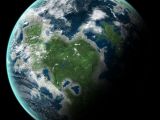 The object revolves around the red dwarf star Gliese 581, which is located about 20 light-years away. It would take a spacecraft using current rocket technologies about 300,000 years to get there.
The object revolves around the red dwarf star Gliese 581, which is located about 20 light-years away. It would take a spacecraft using current rocket technologies about 300,000 years to get there.The most recent studies of the super-Earth body have revealed that it meets all key requirements needed for it to be declared habitable. In addition, scientists have demonstrated with computer models that the planet may in fact be sufficiently warm and wet to allow for the existence of Earth-like life.
Undoubtedly the most important thing about this object is its orbit. It revolves around its parent star at the very edge of the Goldilocks zone, which is the distance from the red dwarf where temperatures are just right to allow for the existence of liquid water.
Investigations carried out in the Gliese 581 star system focused mostly on the proposed exoplanet Gliese 581g, which a group of researchers argued was inhabitable as well. Subsequent studies have since shown that this is not the case.
Therefore, it's only now that Gliese 581d gets the attention it deserves, experts say. The object is around two times larger than Earth is, and has roughly seven times its mass. Details of the latest study appear in the current issue of the Astrophysical Journal Letters, Daily Galaxy reports.
“With a dense carbon dioxide atmosphere – a likely scenario on such a large planet – the climate of Gliese 581d is not only stable against collapse but warm enough to have oceans, clouds and rainfall,” experts with the National Center for Scientific Research (CNRS), in France, say in a press release.
CNRS climate scientists Robin Wordsworth and Francois Forget say in the new study that the planet may in fact not be tidally locked with its parent star. If that is true, then its atmosphere could store sufficient amounts of carbon dioxide to allow for a warming greenhouse effect to start.
“In all cases, the temperatures allow for the presence of liquid water on the surface. [But the planet would] still be a pretty strange place to visit,” the investigators go on to say.
“The denser air and thick clouds would keep the surface in a perpetual murky red twilight, and its large mass means that surface gravity would be around double that on Earth,” they add.
news.softpedia.com








0 comments:
Post a Comment